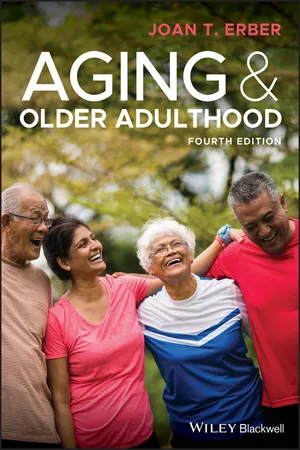
- English
- ePUB (mobile friendly)
- Available on iOS & Android
Aging and Older Adulthood
About this book
Reflects the most important theoretical foundations and research directions concerning aging and older adulthood
This authoritative volume provides the latest insights into, and theoretical interpretation of, our understanding of the human aging process. Newly updated and revised, this edition of the well-established student textbook offers relatable scenarios that touch upon real-world issues faced by older adults and their families. The book explains how research studies attempt to answer questions of both theoretical and practical importance as they relate to aging and older adulthood, and it explains the hypotheses and findings of the studies in a manner that is comprehensible to readers of all levels of research experience.
Aging and Older Adulthood begins by describing the demographic characteristics of the older population, and follows with a chapter on theoretical models that apply to the study of adult development and aging, as well as approaches commonly taken to conduct research and ethical concerns involved in the study of this group. It then offers a series of chapters exploring biological aging, sensation perception and attention, memory, intellectual functioning, cognition and real-world problem-solving, personality and coping, social interaction and social ties, lifestyles and retirement, mental health and psychotherapy, and death and bereavement. The final chapter looks at aging in the future. Each chapter includes fully updated research findings, as well as new and expanded coverage of concepts and ideas in areas such as neuroscience, and diabetes.
- New edition of a highly respected text exploring our contemporary understanding of a broad range of topics related to older adulthood and the psychology of aging
- Offers thematic treatment of core issues including health, sensory perception, memory, intellect, social interactions, employment and retirement, and mental health
- Uses a dual lens of two models – the selective optimization with compensation model and the ecological model – to provide cohesiveness to the presentation of both theoretical and applied material
- Introduces each chapter with a relevant real-world scenario and refers back to it throughout the chapter
- Includes pedagogical feature boxes that reflect current understanding of contemporary issues in the field as well as key points and issues for further discussion
Aging and Older Adulthood, 4th Edition is an excellent text for upper division undergraduate and graduate courses focusing on the older adulthood and aging, the psychology of aging, gerontological studies, and lifespan development.
Frequently asked questions
- Essential is ideal for learners and professionals who enjoy exploring a wide range of subjects. Access the Essential Library with 800,000+ trusted titles and best-sellers across business, personal growth, and the humanities. Includes unlimited reading time and Standard Read Aloud voice.
- Complete: Perfect for advanced learners and researchers needing full, unrestricted access. Unlock 1.4M+ books across hundreds of subjects, including academic and specialized titles. The Complete Plan also includes advanced features like Premium Read Aloud and Research Assistant.
Please note we cannot support devices running on iOS 13 and Android 7 or earlier. Learn more about using the app.
Information
1
Introduction to Aging and Older Adulthood
Chapter Overview
- The Study of Aging and Older Adulthood
- History of the Scientific Study of Aging
- Geriatrics and Gerontology
- Why Was the Study of Aging Neglected?
- Reasons for Studying Aging and Older Adulthood
- Defining Age and Older Adulthood
- Definitions of Age
- What Is Older Adulthood?
- Demographic Profile of Older Americans
- Global Considerations and Demographic Transition
- Number and Proportion of Older Adults
- A Snapshot of the Older Population
- Developmental Influences and Issues
- Influences on Development
- Issues in the Study of Aging
- Understanding Aging Box 1.1: A New Outlook on Old Age
- Theoretical Models
- The Selective Optimization with Compensation Model of Aging
- The Ecological Model of Aging
- Questions to Consider
- Key Points
- Key Terms
Close-ups on Adulthood and Aging
The Study of Aging and Older Adulthood
History of the Scientific Study of Aging
Table of contents
- Cover
- Praise
- Title Page
- Copyright
- Dedication
- Preface and Acknowledgments
- 1 Introduction to Aging and Older Adulthood
- 2 Theory and Method in Studying Aging and Older Adulthood
- 3 Biological Aging and Health
- 4 Sensation, Perception, and Attention
- 5 Memory
- 6 Intellectual Functioning
- 7 Cognition and Problem Solving in the Everyday World
- 8 Personality and Coping
- 9 Social Interaction and Social Ties
- 10 Employment, Retirement, and Living Arrangements
- 11 Mental Health, Psychopathology, and Therapy
- 12 Coping with Death, Dying, and Bereavement
- 13 Looking Ahead: Aging in the Future
- Glossary
- References
- Index
- End User License Agreement